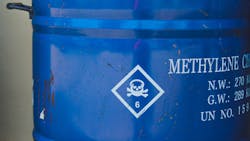EPA Proposes to Ban Most Uses of Methylene Chloride
On May 3, 2023, the U.S. Environmental Protection Agency (EPA) proposed under Section 6(a) of the Toxic Substances Control Act (TSCA) to prohibit most uses of methylene chloride. This column summarizes this important initiative.
Overview
Risks associated with workers, occupational non-users (ONU), consumers and those in proximity to consumer use, drove the EPA’s unreasonable risk determination for this widely used solvent. The EPA identified risks for adverse human health effects, including neurotoxicity, liver effects, and cancer from inhalation and dermal exposures to methylene chloride.
The proposed risk management rule would “rapidly phase down” methylene chloride manufacturing, processing and distribution, most of which would be fully implemented in 15 months. For uses the EPA proposes to prohibit, the agency found alternative products with similar costs and efficacy to methylene chloride are generally available.
Key Provisions
The EPA determined methylene chloride presents an unreasonable risk of injury to health, without consideration of costs or other non-risk factors, including an unreasonable risk to potentially exposed or susceptible subpopulations identified as relevant to the 2020 methylene chloride risk evaluation, under the conditions of use (COU). To address these risks, the EPA proposes:
- Prohibiting the manufacture, processing and distribution of methylene chloride for all consumer use;
- Prohibiting most industrial and commercial use;
- Requiring a workplace chemical protection program (WCPP), including inhalation exposure concentration limits and related workplace exposure monitoring and exposure controls, for 10 COUs;
- Requiring recordkeeping and downstream notification requirements for manufacturing, processing and distribution in commerce;
- Providing a 10-year, time-limited exemption for civilian aviation from the prohibition, addressing the use of methylene chloride for paint and coating removal to avoid significant disruptions to critical infrastructure, with conditions for this exemption to include compliance with the WCPP; and
- Providing a 10-year, time-limited exemption for emergency use of methylene chloride in furtherance of NASA’s mission for critical or essential specific conditions and for which no technically and economically feasible safer alternative is available, with conditions for this exemption to include compliance with the WCPP.
All TSCA COUs (other than consumer paint and coating removers, which were subject to separate action under TSCA Section 6 in 2019) will be subject to this proposal. The EPA requests public comment by July 3, 2023.
The EPA states that proposed risk-based limits are based on recent data and meet the TSCA requirement to eliminate unreasonable risk. After the agency issues the final risk management rule, employers would have one year to comply with the WCPP and must monitor their workplaces periodically to ensure workers are not exposed to methylene chloride levels that would lead to unreasonable risk.
Discussion
The EPA’s approach is likely a template for regulating other priority industrial solvents like 1,4-dioxane, N-methylpyrrolidone (NMP) and carbon tetrachloride. Comment on the proposal is thus essential. The agency requested comment on specific aspects of the proposed rule that readers are encouraged to consider. For example, the EPA discussed its authority under TSCA Section 6(g) to grant a time-limited exemption for specific conditions of use (e.g., civilian aviation), where the EPA finds compliance with the proposed requirement would “significantly disrupt … critical infrastructure.” This exemption would include compliance with the WCPP. If the WCPP is protective and facilities can comply with the WCPP, the time limit seems to go beyond what’s required to protect health and the environment.
TSCA Section 26(h) requires the EPA to make decisions under TSCA Sections 4, 5 and 6 consistent with the best available science, which includes protocols and methodologies like systematic review. The EPA’s use of its 2018 Systematic Review Document in the final risk evaluation also casts doubt on whether it met the requirements for weight of scientific evidence under TSCA Section 26(i), which the agency codified to mean a “systematic review method, applied in a manner suited to the nature of the evidence or decision ….”
Conclusion
Given its precedent-setting potential, careful review and comment on this proposal are recommended. It may well become the standard for regulating other solvents under EPA review.
About the Author
Lynn L. Bergeson, Compliance Advisor columnist
LYNN L. BERGESON is managing director of Bergeson & Campbell, P.C., a Washington, D.C.-based law firm that concentrates on conventional, biobased, and nanoscale chemical industry issues. She served as chair of the American Bar Association Section of Environment, Energy, and Resources (2005-2006). The views expressed herein are solely those of the author. This column is not intended to provide, nor should be construed as, legal advice.

